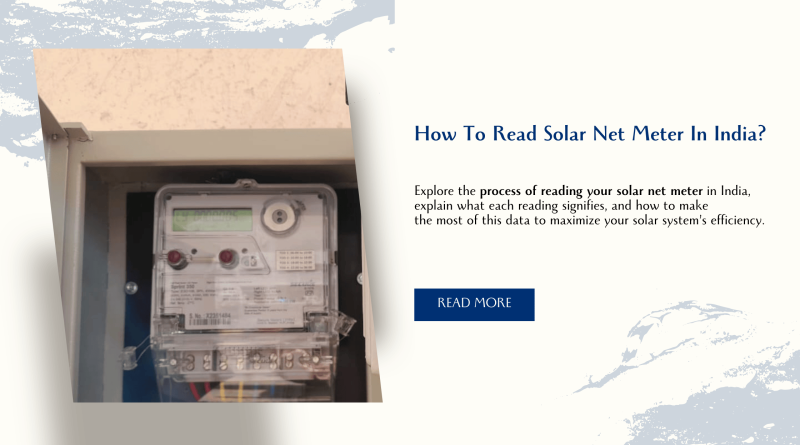How To Read Solar Net Meter In India?
As solar energy becomes increasingly popular in India, more households and businesses are adopting solar rooftop systems. If you’re a solar energy user with a net metering system, understanding how to read your solar net meter is crucial. The net meter not only helps track your solar energy generation but also keeps track of how much power you are drawing from and sending back to the grid.
In this blog, we’ll walk you through the process of reading your solar net meter in India, explain what each reading signifies, and how to make the most of this data to maximize your solar system’s efficiency.
Table of Contents
- 1 What is a Solar Net Meter?
- 1.1 Key Components of a Solar Net Meter
- 1.2 How to Read a Solar Net Meter in India: Step-by-Step
- 1.3 How to Calculate Your Bill Using the Net Meter
- 1.4 Types of Solar Net Meters in India
- 1.5 Benefits of Monitoring Your Solar Net Meter
- 1.6 State-Specific Differences in Net Metering Policies in India
- 1.7 Conclusion
- 1.8 FAQs
What is a Solar Net Meter?
A solar net meter is a bidirectional electric meter that records two types of data:
1. Electricity consumed from the grid when your solar panels are not producing enough power (e.g., during the night or cloudy days).
2. Excess electricity sent back to the grid when your solar panels generate more power than you need (e.g., during peak sunlight hours).
Net metering allows users to offset their electricity bills by subtracting the amount of power sent to the grid from the power consumed from the grid.
Key Components of a Solar Net Meter
Before you start reading your solar net meter, it’s important to familiarize yourself with the display and key metrics that it tracks:
1. Import (Energy Consumed from the Grid): The amount of electricity you’ve drawn from the grid when your solar system is not producing sufficient energy.
2. Export (Energy Sent to the Grid): The surplus energy generated by your solar panels that has been sent back to the grid.
3. Net Energy Metering: This is the difference between the import and export readings, determining your net energy consumption or export over a billing cycle.
4. Other Parameters: Your meter may also display data like voltage, current, and power factor, which are important for technical monitoring but not essential for daily reading.
How to Read a Solar Net Meter in India: Step-by-Step
Step 1: Locate Your Net Meter
Your solar net meter will be installed by your utility company, and it’s typically placed near your main electrical panel or outside your home, similar to a regular electricity meter.
Step 2: Understand the Display
Most modern net meters come with a digital display that cycles through various readings. The display might switch automatically every few seconds, or you may need to press a button to cycle through the different parameters manually.
Look for the following readings on the digital screen:
- Import Energy (kWh): This shows the total amount of energy you’ve consumed from the grid since the installation of your solar system.
- Export Energy (kWh): This indicates the total energy your solar system has sent back to the grid.
- Net Reading (kWh): This is usually the difference between the import and export readings. A positive value means you’ve consumed more energy from the grid than you exported, while a negative value indicates that you’ve exported more energy than you consumed.
Step 3: Identify the Key Readings
Most net meters in India will display the following codes or labels:
1. kWh IMPORT (often displayed as “I” or “IMP”): This is the total electricity (in kilowatt-hours) you’ve drawn from the grid.
2. kWh EXPORT (often displayed as “E” or “EXP”): This represents the total electricity (in kilowatt-hours) you’ve sent back to the grid.
3. NET kWh: This is the overall net reading, which indicates the total electricity consumed or exported. If this number is negative, it means you have a surplus of energy sent to the grid.
Step 4: Use Buttons (If Available)
Some meters come with buttons that allow you to manually cycle through various readings. If the display isn’t cycling automatically, use the buttons to navigate:
- Press the button once to show energy import from the grid.
- Press the button twice to display the energy export to the grid.
- Press the button three times to see other details like voltage, power factor, and instantaneous power.
Step 5: Compare Readings Over Time
By regularly checking your net meter, you can track your solar system’s performance and compare the data over time. This allows you to understand your energy consumption patterns and optimize your usage to save more on your electricity bill.
How to Calculate Your Bill Using the Net Meter
The billing process in a net metering system involves the following calculations:
1. Net Consumption: Subtract the amount of electricity exported to the grid from the electricity imported from the grid. For example, if you’ve imported 500 kWh and exported 300 kWh, your net consumption is 200 kWh.
Formula:
Net Consumption (kWh) = Import (kWh) – Export (kWh)
2. Energy Bill: Your energy bill will be based on the net consumption figure. If your export exceeds your import, you may receive a credit that can be carried forward to the next billing cycle.
3. Surplus Credits: In some states, if you produce more energy than you consume over the billing period, you receive a credit at a pre-determined rate (often lower than the rate charged for consumption).
Types of Solar Net Meters in India
Different types of net meters may have different features, so it’s important to know which one you have installed:
1. Single-Phase Net Meters: Commonly used in households with lower energy requirements, these meters track energy flow on a single-phase connection.
2. Three-Phase Net Meters: Typically used for commercial buildings or larger residential setups with three-phase connections, these meters are capable of handling higher loads and complex energy flows.
3. Smart Meters: These digital meters can provide real-time data about energy consumption and generation. Some smart meters can even be accessed remotely through a mobile app or a web portal.
Benefits of Monitoring Your Solar Net Meter
1. Optimizing Solar Usage: Regularly monitoring your solar net meter helps you track how much energy you consume versus how much you export, allowing you to optimize your energy consumption habits and reduce reliance on grid power.
2. Maximizing Savings: Knowing when your solar panels generate the most electricity helps you adjust your energy usage patterns to take full advantage of solar power, thereby reducing your electricity bills.
3. Early Detection of Issues: A sudden change in your net meter readings could indicate an issue with your solar system or the grid connection, allowing you to address potential problems before they become significant.
State-Specific Differences in Net Metering Policies in India
While the general process for reading a solar net meter is similar across India, net metering policies vary by state. Some states offer favorable rates for surplus energy, while others have specific caps on the size of the solar system eligible for net metering. It’s essential to check your state’s regulations to fully understand how net metering works in your location.
Conclusion
Reading your solar net meter is essential for understanding your energy production and consumption. With net metering, solar users in India can reduce their energy bills and contribute excess power back to the grid. By monitoring your net meter regularly, you can make informed decisions about your energy usage, optimize the performance of your solar system, and maximize your financial savings.
Ready to Save on Electricity Bills with Solar Power?
With Net Metering, you can drastically reduce your electricity costs by generating your own solar power and sending any excess back to the grid. It’s time to harness the sun’s energy and make a positive impact on both your wallet and the environment!
At SolarClue, we make the transition to solar simple, efficient, and affordable. Whether you’re a homeowner, business, or institution, our team of solar experts will guide you through the process—from installation to maintenance—so you can start saving from day one.
🌞 Take the first step towards energy independence today!
🔋 Get your solar consultation now!
Contact SolarClue or call us at +91-888-4444-830 to explore the best solar solutions for your home or business.
Go Solar. Save More. Power Your Future with SolarClue!
FAQs
1. How often should I check my solar net meter?
It’s recommended to check your net meter at least once a month to monitor your solar system’s performance and track energy usage.
2. Can I access my net meter data remotely?
Some smart meters offer remote access via a mobile app or online portal, allowing you to monitor your energy consumption in real time.
3. What happens if I produce more solar energy than I consume?
If your export exceeds your import, you will accumulate credits that can offset future electricity bills or, in some states, be cashed out.
4. What do I do if my net meter stops working?
Contact your utility company immediately if you notice any issues with your net meter, as they are responsible for maintaining and replacing it.
5. Is there any maintenance required for a solar net meter?
The meter itself doesn’t require maintenance, but you should ensure it’s in good working condition and report any malfunction to your utility provider.



